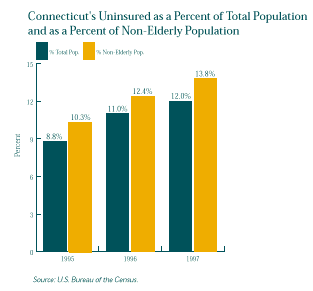 |
Recent Trends
Despite low levels of
unemployment, solid job growth and an improving state economy in recent years, the problem
of the uninsured appears to be growing worse in Connecticut.
- According to the Census Bureau, Connecticut's uninsured population grew from 289,000 in
1995 to 396,000 in 1997.
- In 1995, the uninsured represented 8.8 percent of Connecticut's entire population and
10.3 percent of the non-elderly population (i.e., those under age 65). By 1997, those
figures rose to 12.0 percent and 13.8 percent, respectively.
- While Connecticut's non-elderly uninsured population was smaller than the national
average of 18.3 percent, it was still unacceptably high for the wealthiest state in the
nation.
|
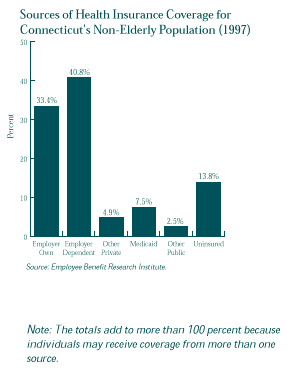 |
Sources of Coverage for the Non-Elderly
- In 1997, nearly three-quarters of non-elderly Connecticut residents obtained health
insurance through an employer, either their own or through a family member's employer.
- Another 4.9 percent purchased coverage for themselves directly from an insurance company
and 10 percent received coverage through Medicaid or another public program.
- A total of 13.8 percent of Connecticut's non-elderly population was uninsured in 1997.
By this measure, Connecticut ranked sixteenth in the nation, down from twelfth the
previous year.
|
The Uninsured by Work Status
- One of the most striking characteristics of the uninsured population is the prevalence
of working families. In 1994-95, 82.8 percent of uninsured Connecticut residents lived in
families where the adults had some connection to the work force.
- About 72 percent of the state's uninsured lived in families where one or both of the
adults worked full-time.
- Only 17.2 percent of the uninsured lived in families where the adults were not working.
|
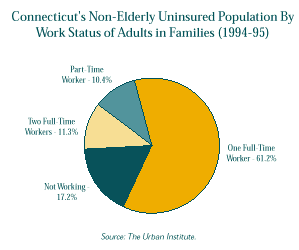 |
The Uninsured by Firm Size
- In 1994-95, only 28.5 percent of Connecticut's workers were employed by small firms
(i.e., those with fewer than 25 employees); yet, 44.9 percent of Connecticut's uninsured
workers were employed by small firms.
- Medium-sized firms ( those with 25-99 workers) employed 11.6 percent of Connecticut's
workers, while 14.2 percent of uninsured workers were employed by medium-sized firms.
- Larger firms (those with 100 or more workers) employed nearly 60 percent of
Connecticut's workers; yet, 41 percent of uninsured workers were employed by large firms.
|
 |
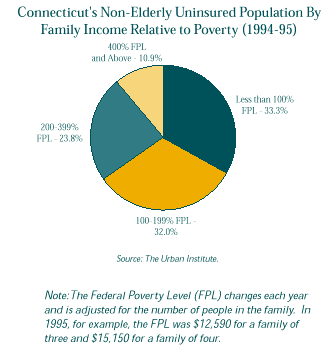 |
The Uninsured by Family Income
- In 1994-95, 14.1 percent of Connecticut families had incomes below 100 percent of the
Federal Poverty Level (FPL); however, 33.3 percent of uninsured families had incomes below
the FPL.
- A total of 13.5 percent of the state's families had incomes between 100-199 percent of
the FPL; yet 32 percent of uninsured families had incomes within that range.
- Families between 200-399 percent of FPL made up 23.8 percent of the uninsured in
Connecticut, while those with incomes of 400 percent or more of the FPL made up the
remaining 10.9 percent.
|
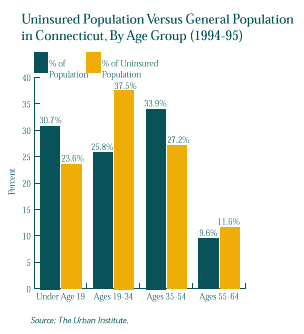 |
The Uninsured by Age
- In 1994-95, those ages 19-34 were the most likely to be without health coverage in
Connecticut. While this age group made up 25.8 percent of Connecticut's non-elderly
population, they represented 37.5 percent of the state's uninsured population.
- Those between the ages of 55-64 were somewhat overrepresented among the uninsured. This
group made up 9.6 percent of the state's non-elderly population, yet represented 11.6
percent of Connecticut's uninsured population.
- Those between the ages 35-54 make up 27.2 percent of the uninsured population and
children under age 19 made up 23.6 percent of Connecticut's uninsured population.
- Significantly, the majority of uninsured Connecticut children lived in families with
incomes below 185 percent of the Federal Poverty Level; this means they were eligible for
health coverage under the Medicaid program.
|
The Uninsured by Family Type
- In 1994-95, single individuals (as a family type) made up 20.5 percent of the population
in Connecticut; yet, singles represented 51.6 percent of the uninsured population.
- By contrast, those in families categorized as "married with children" made up
48.5 percent of the state's population; however, these families represented only 27
percent of the uninsured population.
- Families classified as married without children made up 17.5 percent of Connecticut's
population and represented 12.2 percent of the uninsured population.
- Single-parent families made up 13.6 percent of Connecticut's population, but only 9.1
percent of the uninsured population. If not for the Medicaid program, which largely serves
single-parent families, this population would make up an even larger percentage of the
uninsured.
|
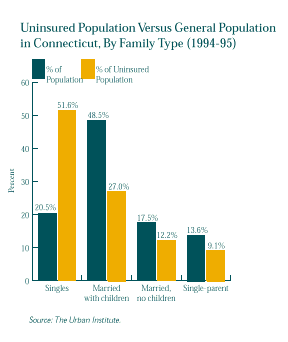 |
 |
![]()